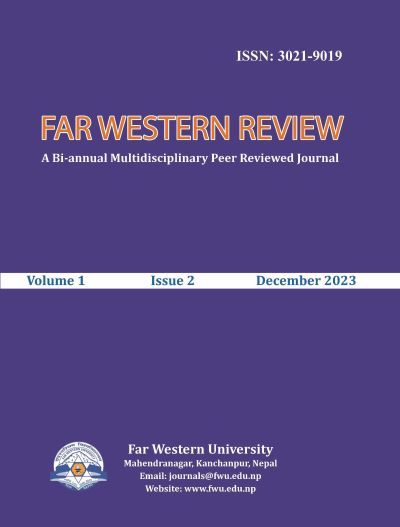Effect of Different Methods and Planting Density on the Growth and Yield of Spring Rice at Tikapur, Kailali
DOI:
https://doi.org/10.3126/fwr.v1i2.62150Keywords:
Chaite Dhan, Transplanting, direct seeding, broadcastingAbstract
A field experiment was conducted at Agronomy farm, Far Western University, Tikapur-1 to study the effect of different planting methods and density on yield of spring rice variety (chaite-4), when sown a month earlier than normal time. The research was laid out in randomized complete block design (RCBD) with seven treatments and three replications during Feb-June, 2022. The treatments consisted of planting methods viz. early broadcasting (T1 ), early line sowing (T2 ) on the day of nursery bed (1st Feb), transplanting 20 hills m-2(T3 ), transplanting 30 hills m-2 (T4 ), transplanting 40 hills m-2 (T5 ), late broadcasting (T6 ) and late line sowing, (T7 ) on the day of transplanting (2nd Mar). The results showed that transplanting significantly outperformed broadcasting method of rice planting in terms of yield attributing traits and yield. Broadcasting method showed significant reduction in tiller number, biological yield and grain yield than line sowing. But performance of late line sown rice was better than early line sown rice. Similarly transplanting 30 hills m-2 showed significant effect in early tiller formation followed by 20 hills-2resulting in significant increase in grain yield of spring rice as compared to transplanting 40 hills m-2. There was no difference in tiller number between line sown rice either early or late. This study recommends sowing of 30 hills m-2 and suggests further research on line sowing of spring rice at different dates ranging from 1st February to 3rd March at same planting density to define appropriate time for preponing planting time under similar condition.
Downloads
Downloads
Published
How to Cite
Issue
Section
License

This work is licensed under a Creative Commons Attribution-NonCommercial 4.0 International License.
CC BY-NC: This license allows reusers to distribute, remix, adapt, and build upon the material in any medium or format for noncommercial purposes only, and only so long as attribution is given to the creator.




